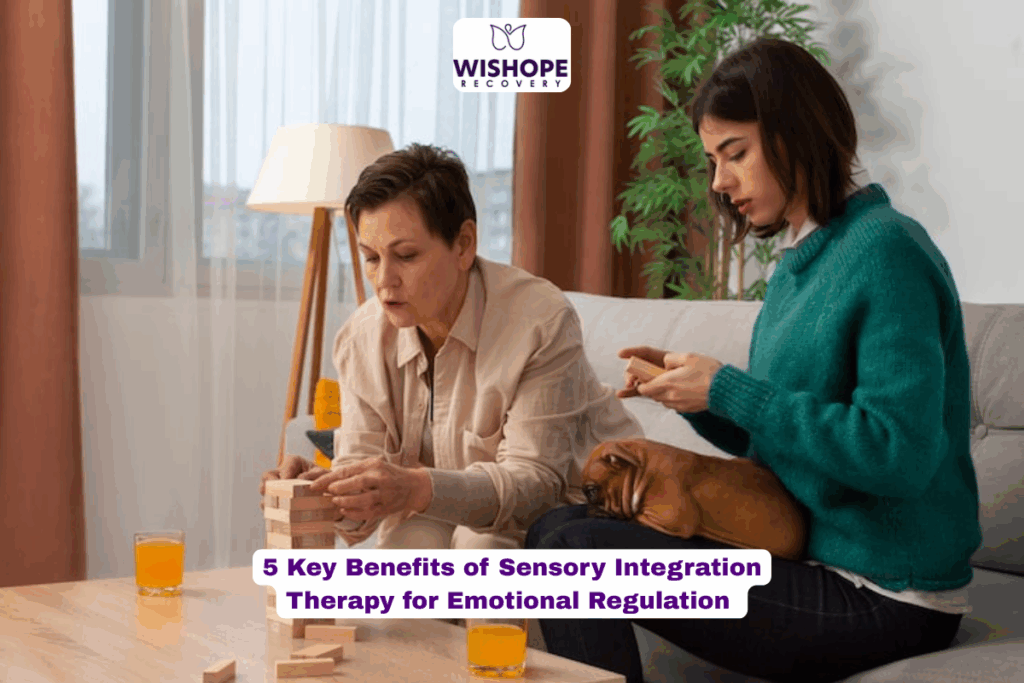Emotional regulation is the ability to shape and temper responses according to the level of stress, change, relationships, and daily demands placed on one’s life. Sensory integration therapy has the potential to be a very effective and life-changing treatment for those individuals who feel easily overwhelmed emotionally, incredibly sensitive, or have a hard time processing sensations. This model of therapy offers long-term improvement in emotional balance, behaviors, and cognition by allowing the brain to better organize the sensory input it receives. Today, many recovery-based programs utilize sensory-based interventions to develop emotional resilience and promote sustainable recovery, including holistic centers such as Wishope Recovery.

1. Enhances the Brain’s Ability to Process Sensory Information
The foundation of emotional regulation is the improvement of sensory processing. As the brain better organizes input from movement, touch, and the environment, emotional responses naturally become more stable and predictable, and thus easier to transition through daily routines without feeling overwhelmed.
A therapist will use purposeful activities: vestibular exercises, tactile stimulation, and proprioceptive input to strengthen the nervous system. Such sensory experiences develop more efficient pathways in the brain to reduce irritation and emotional spikes caused by overstimulation. Some key benefits it ensures include:
- Improved tolerance to sensory environments
- Reduced anxiety from loud/bright stimuli
- Better adjustment to changes or transitions
- Increased presence and calmness
Merging this work with psychodrama therapy allows the client to process emotional patterns while maintaining their grounding, provides a balanced approach that facilitates both sensory and emotional healing.
2. Increases Emotional Awareness and Strengthens Coping Tools
Early recognition of emotional cues is important in keeping the balance of emotions. Sensory-based intervention focuses on teaching the client how to recognize the signs of overstimulation before they increase into anxiety or a shut-down. This creates space for reflective responses rather than impulsive reactions.

Deep-pressure tools, rhythmic movement, visual grounding, and breathing exercises are some of the ways therapists help clients connect with their internal states. With consistent practice, the client will learn exactly which sensory strategies soothe them during a given stressful experience. The main objectives for this section are:
- Greater awareness of emotional triggers
- Better understanding of sensory–emotion links,
- Individualized coping strategies for difficult situations
- Increased mind-body integration
In conjunction with experiential family therapy, families also learn to identify sensory overload and respond with compassionate intent. By supporting communication, this can help to create a safe environment in the home.
3. Reduces Anxiety, Stress, and Emotional Outbursts
A lot of emotional outbursts are due to the body’s inability to process overloaded sensory input. Sensory therapy works to strengthen the way your nervous system responds to input, which will then naturally lower anxiety and create a more regulated internal baseline.

Weighted input, rhythmic swinging, and guided touch are some of the structured sensory activities that help in regulating the autonomic nervous system. These reduce the fight-or-flight responses and enhance the body’s capability for stability during stressful moments. Overall benefits for anxiety and emotional outbursts will include:
- Lower anxiety overall
- Less emotional spikes or shut downs
- More predictable patterns of behavior
- Greater sense of internal control
In addition to this, tools like psychodrama therapy offer healthy emotional release, while tools like recreational therapy near me add further movement based challenges and nature based activities that regulate the nervous system as well.
4. Strengthens Relationships and Improves Communication
Often emotional dysregulation impacts the way in which people communicate with others. Individuals who become overwhelmed too easily can experience breaks down in communication and more often than not relationships suffer. Sensory-based therapy will help the individual remain regulated and grounded during highly charged moments, thereby improving their capability to communicate calmly.

By improving sensory integration, the client remains present and aware during a conversation instead of acting impulsively. This helps create healthier communication patterns and avoids misunderstandings. Another way this approach promotes:
- Better frustration tolerance
- Improved self-expression
- More consistent emotional presence
- Reduced conflicts in relationships
These skills are expanded into the family system when combined with experiential family therapy. Families practice hands-on activities that reveal communication patterns, strengthen empathy, and build more supportive connections.
5. Supports Long-Term Healing and Improves Quality of Life
Sensory integration treatment has long-lasting effects that go well beyond the confines of the therapist’s couch: as the brain learns to interpret sensory messages more efficiently, individuals experience more emotionally balanced feelings, better decision-making, and more confidence in daily life.

Clients often find that emotional responses stabilize naturally and become easier to manage without constant effort. Stability supports better work performance, stronger relationships, and improved overall well-being. Long-term benefits include:
- Predictable emotional responses
- Greater independence and resilience
- Improved problem-solving
- Greater sense of agency and clarity
Wishope and others have family therapy based on sensory methods, psychodrama therapy, and experiential therapy like recreational therapy near me—providing long-term, comprehensive emotional and sensory recovery.
The Path to Long-Term Stability Starts Here
Regulating one’s emotions is not a skill someone just “picks up.” Emotion regulation is regulated by the nervous system, sensory pathways, environmental experiences, relationships, and life experiences. Sensory integration therapy provides one powerful framework for strengthening these foundations and helping individuals regain balance, clarity, and confidence in their emotional world.
When used alongside psychodrama therapy, experiential family therapy, or a holistic program-based service like recreational therapy near me, interventions with a sensory focus will provide a deeply supportive and effective pathway toward recovery. If someone is navigating their trauma recovery journey, emotional challenge on a daily basis, or relationship stress, services like those at Wishope Recovery offer the structure and care to support someone on a journey toward a healthier, more emotionally regulated life.
FAQ’s
Ques1. What is sensory integration therapy?
Ans: Sensory integration therapy is a therapeutic activity that helps the person process sensory information and respond to it in a more adaptive way to level off emotional regulation and participation in daily life.
Ques2. Who would be best served by sensory integration therapies?
Ans: This type of therapy is indicated for individuals who experience emotional dysregulation, sensory overload, increased or decreased sensitivity to experiences stemming from trauma, anxiety, and difficulties concerning sensory processing and development.
Ques3. What support does sensory integration therapy provide for emotional regulation?
Ans: The therapy reduces feelings of being overwhelmed by helping the brain process incoming sensory input differently and thus enhances self-awareness and provides adaptive emotional behaviors.
Ques4. Can sensory integration therapy be combined with other therapeutic approaches? Ans: Yes, sensory integration therapy can complement one another and be used simultaneously alongside methodologies, such as psychodrama therapy, experiential family therapy, and recreational therapy for a holistic healing approach.
Ques5. How long does it take before seeing positive effects from sensory integration therapy?
Ans: While most individuals will experience ‘positive changes’ for emotional regulation and sensory tolerance in weeks, overall long-term gains, usually take months to develop.

